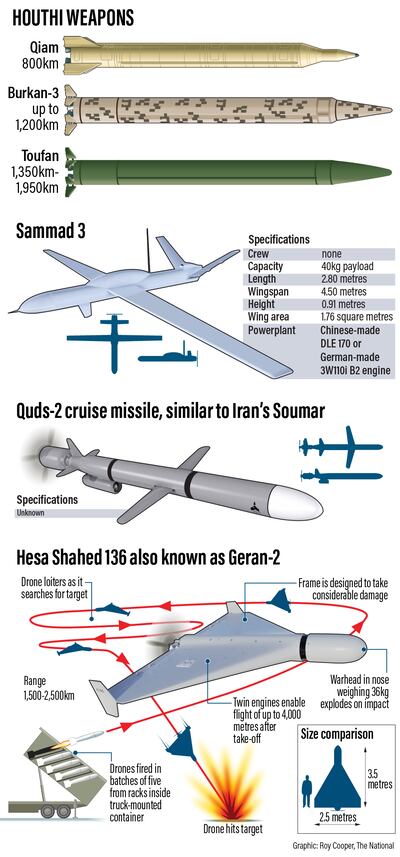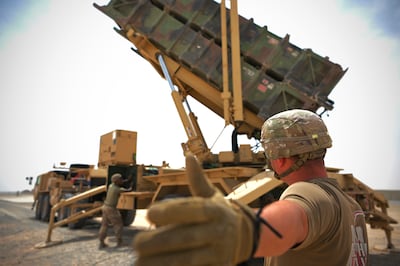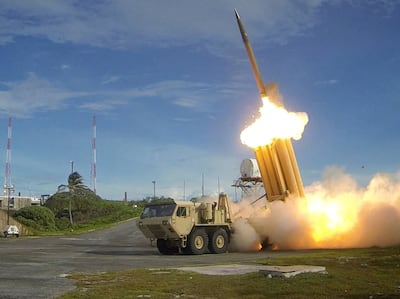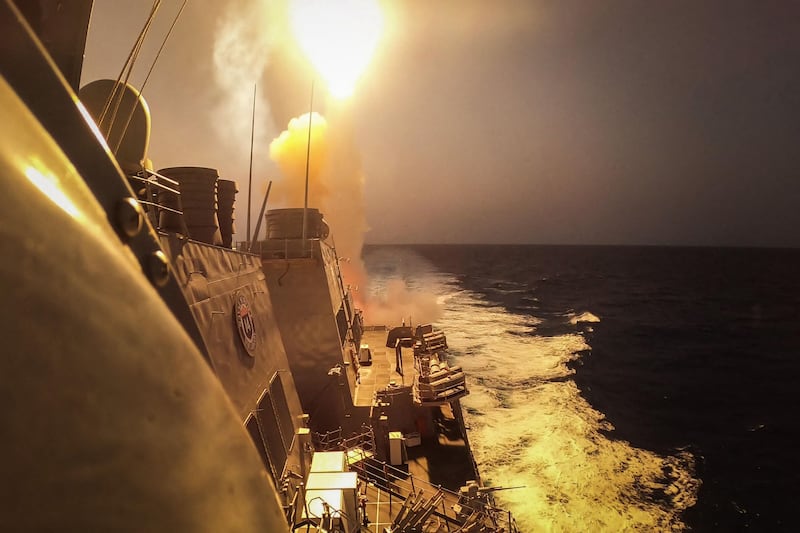Live updates: Follow the latest news on Israel-Gaza
On Wednesday, a US warship in the Red Sea shot down drones and missiles fired towards Israel from Houthi-controlled Yemen, one of up to six incidents of its kind since the Israel-Gaza war erupted on October 7.
The Iran-backed militia has long threatened Israel, but also warns the US that it will become a target if Washington’s support for the war continues.
This raises the prospect that the Houthis' arsenal, donated by Iran and in some cases assembled in Yemen – according to multiple UN reports, could soon be launched directly at US forces, with targets including the USS Thomas Hudner, one of the ships in the Red Sea.
Israel and the US have a range of missile defence systems, developed over decades and used in previous conflicts, to stop the weapons.
What missiles do the Houthis have?
Publicly reported intelligence, including a US briefing to reporters in 2017, says the weapons are mostly Iranian in origin, in some cases Iran-made and smuggled into Yemen for reassembly there. That finding has also been supported by several UN reports.
These weapons include Iran’s Qiam ballistic missile, which flies in an arc high into the atmosphere before returning to the target at up to five times the speed of sound.
That weapon is based on decades-old Soviet Scud missile technology, which Iran has continually modified and improved with modern electronics for navigation and accuracy.
The Houthis' Burkan missile is this Iranian weapon, renamed with some modifications.
But the Qiam is a so-called short-range ballistic missile, meaning it travels less than 1,000km. It has been used by Iran against US forces in Iraq, but is of little use to the Houthis for hitting Israel.

For this task, the Houthis have a far longer range weapon, the Toufan, or Typhoon, which is based on Iran’s Ghadr ballistic missile, with a range of 2,000km.
For drones, the militia have a rocket-launched drone, the Shahed 136 which is now well-known for its use by Russian forces in Ukraine and has a maximum range of 2,000km.
Finally, they have cruise missiles, such as the low-flying Quds-2, which can travel under radar coverage, as well as anti-ship missiles, such as those unsuccessfully launched from Yemen’s coast at a US warship in 2016.
Cruise missiles can be difficult to intercept until they are very close to the target and air forces, including those of Saudi Arabia and Israel, have in some cases hunted them with jet fighters.
Missile defences
A simpler approach to missile defence, however, is missile interceptors. However, the Houthis appear to be launching each type of system at once to catch the US and Israel off guard.
“The worst-case scenario for Israel and its US ally would have been a simultaneous and co-ordinated attack on Israeli territory,” says Pierre Boussel, associate fellow at France's Foundation for Strategic Research.
“One month into the conflict, pro-Iranian armed groups in the Middle East appear to be approaching the Gaza issue in a piecemeal fashion.”

From the US, the most famous air defence system is the Patriot, which has made headlines because of its high demand and limited numbers. It protects US forces in Iraq, allies in the Middle East and US forces in the Pacific.
For the Israelis, Iron Dome, which intercepts small rockets and missiles, has grabbed headlines too. But there are other systems capable of hitting missiles travelling at colossal speeds and altitudes.
Yemen’s Houthi militias fired a long-range ballistic missile towards Israel last week, but the device was destroyed by an Arrow 3 missile, a defence system capable of hitting targets 100km above Earth.
By some accounts, two records were broken: the first space-based combat incident, and secondly, the longest range attack by Houthi militias who were trying to lob a projectile up to 1,900km.

Israel Aerospace Industries president and chief executive Boaz Levy called it a “historic interception” that illustrated Israel’s multi-layered air defences.
For the Houthi missile to reach such a distance, experts say it would need an extremely high ballistic arc.
According to the Missile Defence Advocacy Alliance, a US think tank, the Arrow 3 is designed to intercept missiles in the terminal phase of flight – as they’re starting to descend, and before they reach extremely high speeds.
Layered air defence
Modern air defences consist of layered interceptor systems, broadly characterised as short-range, medium-range and long-range, high-altitude.
Some are optimised to shoot down low-flying projectiles, such as Israel’s Iron Dome that can hit drones or rockets up to several kilometres in altitude. The US-Norwegian Nasams system also falls into this category.

Others cover a high to medium-altitude bracket. They target tactical ballistic missiles at altitudes from 20km to 30km at ranges between 70km and about 400km, as well as short-range ballistic missiles with ranges up to around 1,000km. As a last resort, drones can be hit by these as well.
Israel’s David’s Sling, Russia’s S-400 and the US Patriot systems fall into this category.
A third category is an outlier, the US Thaad system, which does not have a long range but can hit missiles at incredible altitudes, over 150km.
Anything higher altitude than this with a very long range – missiles that can travel hundreds of kilometres – is left to the Arrow, or for the US, Aegis.
The latter system, used by the USS Thomas Hudner, can shoot down ballistic missiles like the Toufan, and even hit a disused satellite 247km above Earth in 2008.






